From environmental pathogens to modern diet, our cells are inflammaging – aging through increased inflammation. How can yoga help?
By Leonie Taylor and Charlotte Watts, co-authors of Yoga & Somatics for Immune & Respiratory Health

‘Inflammaging’, a term coined by Italian researcher Claudio Franceschi in 2000, refers to the low-grade chronic inflammation that often characterises the ageing process. This may partially explain why some older people suffer more from diseases such as COVID-19. Beyond this pandemic, many refer to the creeping symptoms related to inflammation – such as joint pain, loss of mobility or issues related to immune and respiratory health – as an inevitable sign of ageing1.
Continue reading










 Singing Dragon was proud to publish Restoring Prana: A Therapeutic Guide to Pranayama and Healing Through the Breath for Yoga Therapists, Yoga Teachers, and Healthcare Practitioners by Robin Rothenberg in December 2019, to critical acclaim. We are therefore delighted to announce that
Singing Dragon was proud to publish Restoring Prana: A Therapeutic Guide to Pranayama and Healing Through the Breath for Yoga Therapists, Yoga Teachers, and Healthcare Practitioners by Robin Rothenberg in December 2019, to critical acclaim. We are therefore delighted to announce that